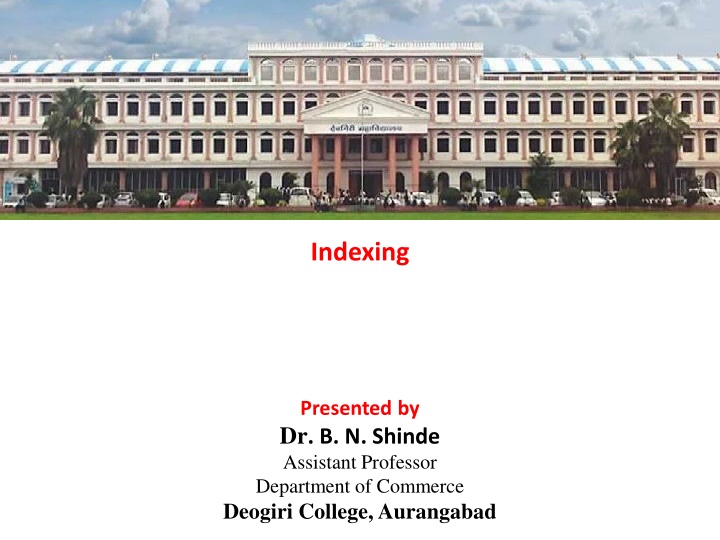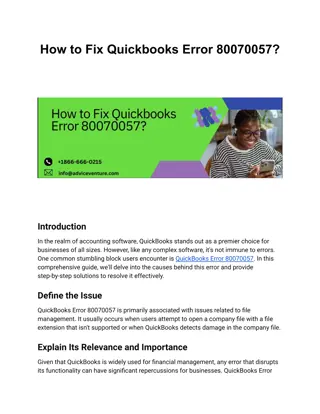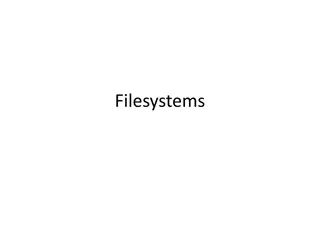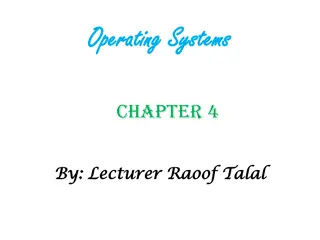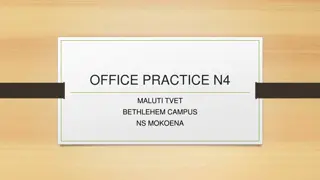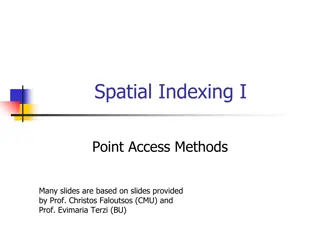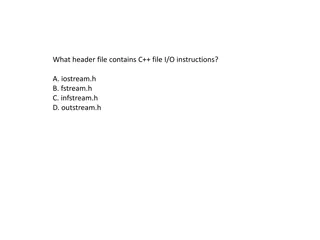Indexing: An Essential Guide for Efficient File Management
Indexing is a crucial process in organizing and locating documents efficiently. Learn about the meaning, objectives, and essentials of a good indexing system to streamline your office operations.
Download Presentation

Please find below an Image/Link to download the presentation.
The content on the website is provided AS IS for your information and personal use only. It may not be sold, licensed, or shared on other websites without obtaining consent from the author.If you encounter any issues during the download, it is possible that the publisher has removed the file from their server.
You are allowed to download the files provided on this website for personal or commercial use, subject to the condition that they are used lawfully. All files are the property of their respective owners.
The content on the website is provided AS IS for your information and personal use only. It may not be sold, licensed, or shared on other websites without obtaining consent from the author.
E N D
Presentation Transcript
Indexing Presented by Dr. B. N. Shinde Assistant Professor Department of Commerce Deogiri College, Aurangabad
What is an Index? Index is a ready-made guide, which is used to locate the required file. Therefore, an index indicates or points out the exact place of keeping a document or file. Indexing is the process of determining the name, subject, or some other caption under which the documents are to be filed. Index is not only necessary to large office but also necessary to small office. When a large number of files are maintained, the necessity of maintaining index is increased. Indexing increases the utility of filing by providing an easy reference to the files. The very purpose of maintaining index is that easy and quickly location of filing.
Meaning of Indexing Indexing means an arranged system through which the required documents and papers are easily located for the speedy disposal of urgent and/or ordinary matters. The various files are maintained for different departments on various topics. Therefore, an indicator (index) is necessary to locate the files.
Objectives of Indexing The objects of indexing are presented below. 1. To assist filing so that the filed documents are located easily and quickly whenever they are needed. 2. To increase the efficiency of the filing method. 3. To improve the efficiency of the office operation. 4. To state the key information regarding any subject in a condensed form. The right system of indexing must be chosen in order to achieve the objectives of indexing. Indexing is not required if files are arranged in an alphabetical order.
Essentials of a Good Indexing System The following are the essential features of a good system of indexing. 1. Simplicity: An indexing system should be simple to understand and operate. It should not involve unnecessary complex in operation. 2. Economy: It should be economical in terms of money, space, and effort. The purchase of indexing equipment requires heavy investment during initial period. Therefore, proper attention should be devoted to ensure economical use in the end. 3. Flexibility: The selected index system should have sufficient scope for expansion. A single system may be used for several purposes. For example, the location of file, supply of important information and the like.
Continue.. 4. Efficiency: Any index system should ensure speed in operation and requires minimum time for operation. 5. Safety: The index system should protect the records against dust, fire, water, rats, insects, water etc. The safety should be equipped with lock facility to prevent pilferage of records. 6. Conformity with Filing System: The selection of index method depends upon the nature and type of filing system adopted in an organization. Hence, there must be a correlation between the filing system and index method.
Continue.. 7. Cross Reference: There should be Cross reference under the head under which a document could be filed but has not been filed. 8. Signaling: A tab or slip should be attached at the edge of the card or file. The tab or slip contains facts of the document briefly. This is used to draw the attention of the needy persons of files.
Types of Indexing 1. Book Index The other name of book index is page index and ordinary index. The names of customers or documents or other information are entered in a book in an alphabetical order under this type. One can trace the page number of a customer by referring first letter of the concerned customer. Then, the desired information or data have been obtained. For example, if one wants to know the debts due to him by a customer named Shankar, refer the page number allotted to Shankar by seeing the name of the customer (i.e. Shankar) in S series: There is no need of much time to know the accounts or information relating to Shankar. This system is highly suitable to small concerns and not suitable to large organization. In case of large organization, there may be many customers in a similar name. Besides, enough space is not available for making many entries in a single name.
Types of Indexing 2. Vowel Index There are many names beginning with same alphabet. Therefore, it is very difficult to find the particulars of a specified customer. For example. Anand, Anandaraj, Anandan, Anand Babu, and the like. The first five letters are common in these names. Hence, these names are sub- divided again based on vowels. If so, one can easily locate the page number of respective customers. This is an improved system of book index. Moreover, vowels are adapted to differentiate the system. Hence, this system is called vowel index. This method of index is suitable to small and medium size business office.
Types of Indexing 3. Bound Book Index This type of index is maintained as in the form of bound book or register. This book is divided into alphabetical sections in which the names of customers or documents are entered, The leaves of each section may be out at the top of right hand side. If so, the initial letters of all the sections are seen at a glance. The entries pertaining to a specific letter of the alphabet are arranged in the same section or page reserved for the same letter of the alphabet very strictly. The cost for maintaining a book index is very cheap. Besides, the durability of book index is very long period. The pages cannot be lost, discarded, or disarranged since they are bound. This type of index is very suitable to small business office.
Types of Indexing 4. Loose Leaf Index This index is other wise called Loose Leaf Book Index. This is another form of book index. Loose Leaf is a ruled sheet like the pages of ordinary index. These sheets are inserted in or taken out from metal hinges or screws, when necessary. Each customer is allotted a leaf in which the name of customer, the address, phone number, call number, fax number, E-mail, the file number etc. are arranged. These loose indices are kept in a drawer.
Types of Indexing 5. Card Index or Vertical Card Index A uniform size of the cards is used under this method. The length of the card may be 4 or 5 and width of the card may be 2.5 or 3 . These cards are maintained vertically. Hence, this method is called vertical card Index. The name and important particulars of a customer are indexed. The file number of the concerned customer is recorded at the top edge of the card.
Continue.. Different colour cards may be used to differentiate and easy location of the files. Cards are arranged in an alphabetical or numerical order. Cards are placed in drawers or boxes in suitable dimensions. Each drawer may have a rod running from one end to other end to hold the cards in a position.
Types of Indexing 6. Visible Card Index This method is an improvement of card Index. Hence, this card index removes the defects of card index. A large number of cards cannot be seen at one sight. Even though, a limited cards can be seen at one sight since many cards are placed flatly in transparent covers. These covers are kept in a shallow tray or metal frame.
Continue.. The metal frame is placed in such a way that the name and address are visible without touching another card. Then, the trays or frames are fitted vertically to metal stands or horizontally into cabinets. The cards are arranged in alphabetical, numerical, or alphanumerical order. The details can be written on the either side of the card without removing the card from the frame.
Types of Indexing 7. Strip Index There is a need of maintaining a list of names and communication address of customers and suppliers in every business office for ready reference. Hence, strip index has been designed to meet the above mentioned purpose. One line entry is made on a narrow strip of cardboard. Each strip contains a single item. The strips are placed in a frame in such a way that the strips can be inserted or removed without much difficulty.
